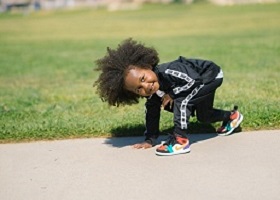By Shay Stinson

Childhood obesity effects physical and social health which makes it a very complex disease. Photo by Marie Michele Bouchard
Overtime, nutritional guidelines for children have changed. We once believed three square meals a day was all a child needed for balanced nutrition and that, because children grow so quickly, there was no need to closely monitor their nutrition. Now, science and medicine can provide more in-depth information on health and wellness than ever before, improving our guidelines for nutrition.
We now know that nutrition plays a major role in behavior and properly developing cognitive functions in children. A proper balance of nutrients such as iron and folic acid can ensure brain functioning and development in the early years of growth. Poor nutrition and socioeconomic food disparities are known contributors to childhood obesity. Childhood obesity can trigger an onset of physical and emotional issues with detrimental outcomes like depression and anxiety.
According to data from a 2015 – 2016 Centers for Disease Control (CDC) report, “for children and adolescents age 2 to 19 years old, the prevalence of obesity was at 18.5% and affected about 13.7 million children and adolescents. For children aged 2 to 5, obesity prevalence was at 13.9%. Youth aged 6 to 11, experienced obesity at 18.4%. Lastly, 20.6% of teens aged 12 to 19 were obese.” Furthermore, childhood obesity is also more common among certain populations.

Youth that struggle with obesity often cry out for support in ways that go ignored. | Photo by Dollar Gill
Potential health concerns like high blood pressure and diabetes due to poor nutrition and childhood obesity, can be easy to identify, especially with the use of regular doctor visits and wellness checks. There is also an emotional burden of childhood obesity that may be overlooked. Childhood obesity can lead to and be caused by emotional stress, depression, bullying, or low self-esteem. These factors can lead a child becoming a bully, becoming suicidal, and acting out physically.
Social norms and weight-based discrimination don’t allow much social acceptance for children suffering from childhood obesity. Parents and caregivers can play an active role in listening and being emotionally supportive to children that are living with obesity. Reinforce that their feelings are valid and that you have space for their concerns. Obesity is a disease and it is not an easy fix. Make sure you’re supporting your children’s health goals for the long haul and not just temporarily treated for something that can have longterm effects.

Parents and supporters can be great role models for fighting childhood obesity by getting out there and joining the fun! | Photo by Rafaela Biazi
Ideally, the overall goal would be to prevent or overcome childhood obesity with the use of great nutritional plans and goals, as well as, regular physical activity. Keeping children physically active is an easy way to combat childhood obesity. There are many activities that appeal to various age groups like team sports, individual sports, and competitive leagues. Give your child options and see what they’re interested in. Be supportive of the physical extracurricular activity they choose.
Here are a few ways to get your child active and moving and to encourage physical activity:
- Make nutrition fun! Get them involved in meal planning. Continue to make family favorites with a healthy twist.
- Turn off technology. For at least an hour a day, unplug and take a walk.
- Consult with a nutritionist and doctor for recommendations.
- Be a role model. Get outside and play with your children.
- Keep it simple. Overplanning will overwhelm you. Hopscotch, jump rope, and basketball are a few straightforward activities.

